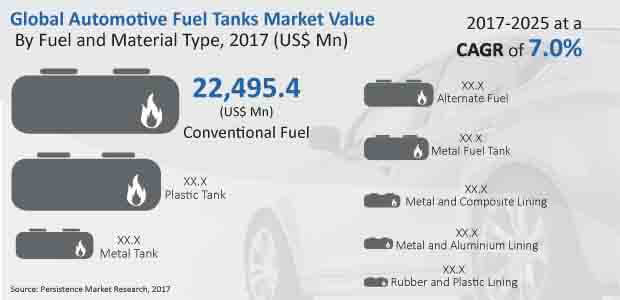Automotive Fuel Tanks Market Segmented By Metal Tank, Plastic Tank as Conventional Fuel in Passenger Car, LCV, HCV
Industry: Automotive & Transportation
Published Date: August-2017
Format: PPT*, PDF, EXCEL
Delivery Timelines: Contact Sales
Number of Pages: 262
Report ID: PMRREP3548
Key stakeholders in the automotive fuel tanks market are investing massive amounts in R&D that should spur the development of innovative technologies. This is anticipated to give rise to demand for advanced plastic and metal fuels among consumers, which will boost the growth of the automotive fuel tanks market during the course of the forecast period.
R&D has enabled manufacturers to develop automotive fuel tanks that can withstand harsh climatic conditions and maintain their durability without undergoing much variation. Advanced automotive fuel tanks have features such as self-sealing, corrosion resistance alloy, recyclability, and several layers that increase their appeal among consumers in the automotive fuel tanks market.
Manufacturers across the world are replacing metal fuel tanks with plastic fuel tanks to meet the rising demand and satisfy discerning customer requirements. Plastic fuel tanks have several inherent advantages over metal fuel tanks and this is enhancing their popularity in the automotive fuel tanks market.
Some of the benefits of plastic tanks over metal include their lightweight build, design flexibility, corrosion resistance, and durability; making them highly sought after in the automotive fuel tanks market.
Consumption of plastic fuel tanks was pegged at 79,054.6 units in 2017 and is expected to reach nearly 128,350.0 units by 2025 end. Sales of plastic fuel tanks is estimated to be valued at US$ 19,503.1 Mn in 2017 and is slated to reach US$ 34,084.8 Mn by 2025. This reflects a CAGR of 7.2% in terms of value over the forecast period.
Consumption of metal fuel tanks was pegged at 15,425.5 units in 2016 and is expected to reach nearly 22,414.9 units by 2025 end. Sales of metal fuel tanks is estimated to be valued at US$ 2,992.3 Mn in 2017 and is slated to reach US$ 4,552.4 Mn by 2025. This reflects a CAGR of 5.4% during the forecast period.

The high cost of plastic fuel tanks is quite likely to be the biggest challenge, restraining widespread adoption of plastic fuel tanks in the automotive fuel tanks market. This is especially relevant in regions such as Latin America, APEJ, and MEA, where customers are typically more price-sensitive than their North American and European counterparts.
For e.g., in Latin America, buyers actually prefer metal fuel tanks as they are cheaper and this far outweighs any benefits that plastic may have in the automotive fuel tanks market, real or perceived.
The 21st century will be dominated by discussions of the impending fuel crisis and alternate sources of fuel in the automotive industry. The two most mentioned subjects of interest are battery operated and electric cars. Both these technological marvels are expected to pose an existential threat to the automotive fuel tanks market as neither requires a fuel tank.
In addition, electric vehicles are more efficient, easy to use, and cost-effective in the long run. Electric vehicles have become very popular in Europe as consumers in European countries seek environmentally friendly vehicles. Consumers have become fairly skeptical of diesel powered vehicles in Europe and this is predicted to negatively impact the global automotive fuel tanks market.
| Attribute | Details |
|---|---|
|
Fuel and Material Type |
|
|
Capacity |
|
|
Vehicle Type |
|
|
Sales Channel |
|
|
Region |
|
To know more about delivery timeline for this report Contact Sales
